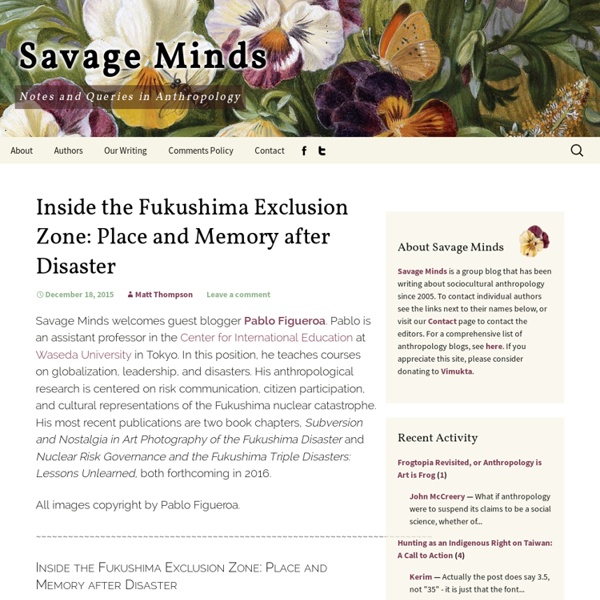



CAA Workshop ‘What happens when artists and anthropologists are asked to do something together rather than talk from the safety of their own practice?’ Anna Grimshaw, Connecting Art and Anthropology participant. The Connecting Art and Anthropology (CAA) workshop brought together 14 international artists and anthropologists to explore some possible answers to this question. Minoans Were European, Genetic Study Reveals The Minoans, the builders of Europe's first advanced civilization, really were European, new research suggests. The conclusion, published today (May 14) in the journal Nature Communications, was drawn by comparing DNA from 4,000-year-old Minoan skeletons with genetic material from people living throughout Europe and Africa in the past and today. "We now know that the founders of the first advanced European civilization were European," said study co-author George Stamatoyannopoulos, a human geneticist at the University of Washington. "They were very similar to Neolithic Europeans and very similar to present day-Cretans," residents of the Mediterranean island of Crete. While that may sound intuitive, the findings challenge a long-held theory that the ancient Minoans came from Egypt. First European Civilization
ANU - Research School of Humanities & the Arts - RSHA Selected Publications: Books and Monographs The Corporeal Image: Film, Ethnography, and the Senses. Viking History: Facts & Myths The Vikings were a seafaring people from the late eighth to early 11th century who established a name for themselves as traders, explorers and warriors. They discovered the Americas long before Columbus and could be found as far east as the distant reaches of Russia. While these people are often attributed as savages raiding the more civilized nations for treasure and women, the motives and culture of the Viking people are much more diverse. These raiders also facilitated many changes throughout the lands from economics to warfare. Many historians commonly associate the term “Viking” to the Scandinavian term vikingr, a word for “pirate.”
Jean Rouch: A Tribute Jean Rouch was a universally-acclaimed filmmaker, anthropologist, civil engineer, explorer, and storyteller. His sudden death in February 2004 has brought an outpouring of gratitude and memories from friends, colleagues, students and audiences around the world. Documentary Educational Resources, the major North American distributor of Rouch's films, presents this site in collaboration with Brenda Baugh, Craig Johnson and Talisman Interactive. Evidenced-Based Advocacy: (Mis)-Understanding Abortion Regret Evidenced-Based Advocacy is a new bi-monthly column that aims to bridge the gap between the research and activist communities. It will profile provocative new abortion research that activists may not otherwise be able to access. “I Regret My Abortion:” we’ve all seen this infamous anti-choice sign, whether at a rally or outside a clinic. As pro-choice activists, our knee-jerk reaction may be to respond, whether aloud or in our own minds, with a reference to the plethora of research that suggests that relief, not regret, is the most commonly reported feeling after abortion.
Occult science Occult science is the systematic research into or formulation of occult concepts in a manner that follows - in its method or presentation - the way natural science researches or describes phenomena of the physical world. The idea of Occult Science appears in late-19th and early 20th century occultism, especially Theosophy, including: Helena Blavatsky (who describes it as "The science of the secrets of nature — physical and psychic, mental and spiritual"[1]);Rudolf Steiner, whose Occult Science, a sequel to his earlier work Theosophy, deals with the evolution of the human being and the cosmos, as well as referring to the attainment of supersensible knowledge;Alice Bailey, who brought the idea of occult science into association with esoteric astrology.
THE TEACHING OF VISUAL ANTHROPOLOGY - Jay Ruby Jay Ruby Department of Anthropology Temple University, Philadelphia From The Teaching of Visual Anthropology, Paulo Chiozzi, editor. Firenze: Editrice Il Sedicensimo. 1989. (Note - Original page numbers have been preserved for citations purposes.) Visual Anthropology appears to be in a perpetual state of flux. Unable to find a niche with a reasonably secure power base, it occupies a position marginal to mainstream academic social science and to the commercial worlds of independent film and educational television.
Derinkuyu Underground City In Derinkuyu Turkey there is an underground city with 11 levels. It's able to hold up to potentially 20 THOUSAND people. It has wine cellars, stables for livestock, and even what appear to be chapels. The openings to each level are guarded by a huge circular rock door that can be shut by a single person from the inside to keep people out.